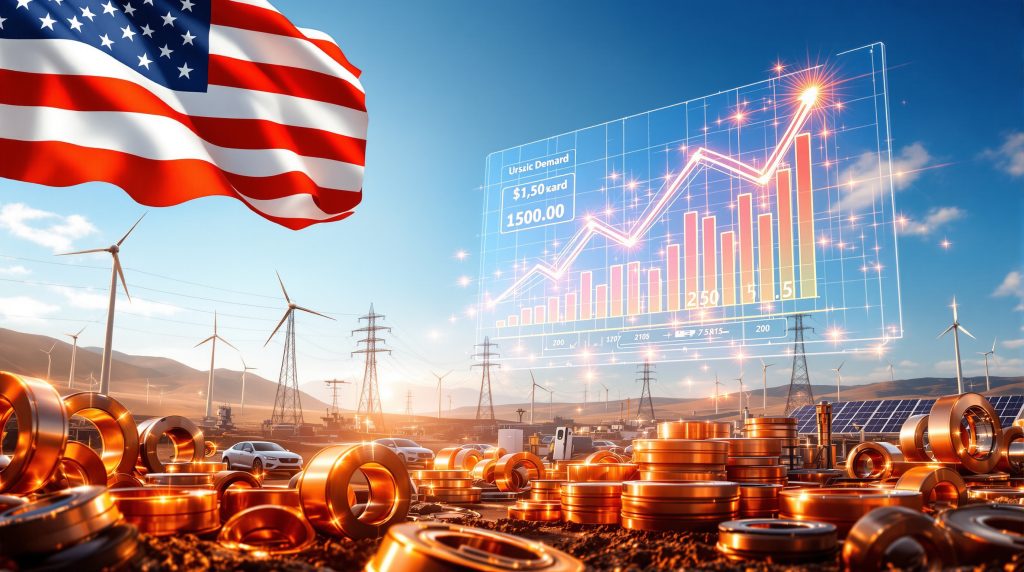Understanding Critical Minerals and Their Strategic Value
Critical minerals represent essential materials that underpin national security, economic stability, and technological advancement while facing significant supply chain vulnerabilities. These strategic resources enable governments to prioritise domestic production initiatives, allocate research funding effectively, and develop comprehensive stockpiling strategies. The classification system helps nations identify materials where import dependency creates unacceptable risks to economic competitiveness and defence capabilities.
The designation process evaluates materials across multiple dimensions, including supply concentration risks, economic importance across diverse sectors, substitution feasibility, and import dependency ratios. Materials earning copper critical minerals list status typically demonstrate high vulnerability to supply disruptions while maintaining essential roles in key industries ranging from defence manufacturing to clean energy infrastructure.
Copper's Essential Role in Modern Electrical Systems
Copper functions as the backbone of global electrical infrastructure due to its exceptional electrical and thermal conductivity properties. With conductivity reaching approximately 59.6 × 10⁶ siemens per meter at standard conditions, copper outperforms virtually all alternative materials except silver in electrical applications. This fundamental physical advantage makes copper irreplaceable in power generation systems, transmission networks, and electronic devices across residential, commercial, and industrial sectors.
Modern economies depend extensively on copper's unique combination of conductivity, malleability, corrosion resistance, and cost-effectiveness. The metal's technical specifications enable efficient electricity transmission with minimal power losses, while its durability ensures long-term infrastructure reliability. From residential wiring systems to industrial machinery, copper's material properties directly impact energy efficiency and operational performance across virtually every electrical application.
Clean Energy Transition Drives Unprecedented Copper Demand
Renewable energy technologies require substantially higher copper content compared to traditional fossil fuel systems. Wind energy installations demonstrate this intensity clearly, with modern turbines incorporating extensive copper components in generator windings, power electronics, and grid connection systems. The electrical infrastructure supporting renewable energy integration demands significant additional copper for smart grid technologies and energy storage systems.
Electric vehicle adoption represents another major demand driver transforming copper consumption patterns. EV powertrains utilise substantially more copper than internal combustion engines due to their electrical intensity. Furthermore, the critical minerals & energy security implications become increasingly apparent as nations prioritise clean energy transitions.
Key applications include:
• Motor windings: High-performance copper conductors for efficient torque generation
• Battery systems: Copper foil separators and intercell connectors
• Power electronics: Inverter components and thermal management systems
• Charging infrastructure: Heavy-gauge copper conductors for rapid charging capabilities
How Copper Achieved Critical Mineral Recognition
The 2025 Strategic Minerals List Expansion
The United States officially added copper to its critical minerals list in November 2025, alongside metallurgical coal, potash, rhenium, silicon, and lead. This policy shift reflects growing recognition of copper's strategic importance beyond traditional industrial applications, particularly in clean energy infrastructure and advanced manufacturing sectors.
According to the Department of Interior announcement, the revised list serves as a blueprint for securing materials essential for defence, manufacturing, and clean energy technologies. The designation directly influences federal investment priorities, permitting procedures, and research funding allocation while signalling strategic value expectations to private sector investors. Moreover, the new critical minerals designation demonstrates Washington's commitment to reducing foreign dependency on strategic materials.
The expansion demonstrates Washington's commitment to reducing foreign dependency on strategic materials, particularly given China's dominance in global mineral refining capacity. Officials emphasised that critical minerals underpin key industries, drive technological innovation, and support infrastructure vital to modern economic competitiveness.
Supply Chain Vulnerabilities Creating Strategic Risks
Geographic concentration in copper refining creates significant strategic vulnerabilities for consuming nations. China processes approximately 40% of worldwide refined copper production, creating potential supply disruption risks during geopolitical tensions or trade disputes. This concentration reflects broader patterns where strategic mineral processing capacity becomes concentrated in limited geographic regions.
| Risk Factor | Current Status | Strategic Impact |
|---|---|---|
| Refining concentration | China dominates 40% of capacity | High supply disruption risk |
| Import dependency | Significant U.S. reliance on imports | National security vulnerability |
| Infrastructure gaps | Limited domestic processing | Economic competitiveness challenge |
| Geopolitical tensions | Trade restrictions precedent exists | Supply chain weaponisation potential |
Recent precedent demonstrates how geopolitical tensions can disrupt strategic mineral supply chains. Beijing's decision to impose additional 15% tariffs on U.S. coal imports illustrates potential weaponisation of mineral trade relationships. Such actions highlight vulnerabilities in supply chains concentrated in specific countries or regions. Consequently, understanding the tariff impact on copper becomes crucial for strategic planning.
Economic Impact Assessment Driving Policy Decisions
The Department of Interior evaluation process considers multiple criteria when designating critical minerals. Supply risk assessment examines geographic concentration, political stability, and trade relationship dynamics. Economic importance evaluation analyses the mineral's role across defence, manufacturing, energy, and technology sectors.
Substitution analysis determines whether alternative materials can effectively replace the mineral in key applications. For copper, limited substitution options exist due to its unique combination of electrical conductivity, thermal properties, and cost-effectiveness. Alternative conductors like silver offer superior performance but prohibitive costs, while aluminium requires larger conductor sizes and different installation methods.
Industries Most Dependent on Copper Supply
Power Generation and Distribution Infrastructure
Electrical infrastructure represents copper's largest consumption sector globally, reflecting the metal's fundamental role in efficient power systems. Power generation facilities utilise copper in generator windings, where high conductivity enables efficient conversion of mechanical energy to electrical power. Thermal power plants, nuclear facilities, and renewable energy installations all require substantial copper quantities for optimal performance.
Transmission and distribution networks depend heavily on copper conductors for efficient power delivery across vast distances. High-voltage transmission lines utilise copper or copper-cored conductors to minimise power losses during long-distance electricity transport. Distribution substations contain copper transformers, busbars, and switching equipment essential for voltage regulation and power routing.
The ongoing grid modernisation initiative substantially increases copper requirements. Smart grid technologies incorporate copper in:
• Advanced metering infrastructure: Digital communication and measurement systems
• Grid automation equipment: Remote monitoring and control devices
• Energy storage integration: Battery systems and power conditioning equipment
• Renewable energy connections: Wind and solar farm grid integration systems
Transportation Electrification Revolution
Electric vehicle proliferation fundamentally transforms copper consumption patterns in transportation. Unlike internal combustion engines that require minimal copper content, electric powertrains demand substantial quantities for optimal performance and efficiency. This shift represents one of the most significant demand drivers in copper markets.
EV Component Copper Requirements:
Traction motors: Permanent magnet and induction motors require high-purity copper windings for efficient torque generation. Motor power output directly correlates with copper content, as higher performance applications demand larger conductor cross-sections and more complex winding configurations.
Battery systems: Lithium-ion batteries incorporate copper foil as current collectors, with thickness typically ranging from 8-12 micrometers. Battery management systems require copper conductors for cell monitoring and thermal management functions.
Power electronics: Inverters converting DC battery power to AC motor drive utilise copper heat sinks and high-current connectors. Silicon carbide and gallium nitride power semiconductors require excellent thermal management, making copper heat dissipation essential.
Charging infrastructure: Level 2 residential chargers specify 6-10 AWG copper conductors, while DC fast charging systems require 2/0 to 4/0 AWG cables capable of handling high current loads safely.
Construction and Smart Building Technologies
Modern construction incorporates copper across multiple building systems, from traditional plumbing and electrical applications to advanced automation technologies. Residential construction typically requires 50-150 metres of copper plumbing, depending on building size and layout complexity. Commercial buildings demand substantially larger quantities for HVAC systems, electrical distribution, and specialised applications.
Smart building integration significantly increases copper requirements beyond traditional construction applications. Building automation systems utilise copper for:
• Sensor networks: Temperature, humidity, occupancy, and security monitoring
• Communication systems: Data transmission for integrated building management
• Power management: Intelligent electrical distribution and load balancing
• HVAC optimisation: Advanced climate control and energy efficiency systems
Data Centres and Digital Infrastructure
Digital infrastructure expansion drives substantial copper demand through server cooling systems, power distribution, and high-speed data transmission applications. Modern data centres require extensive copper infrastructure for reliable operations and thermal management.
Power distribution in data centres utilises copper busbars and conductors rated for high current densities. Uninterruptible power supply systems incorporate copper transformers and switching equipment for backup power reliability. In addition, cooling systems require copper heat exchangers and pump systems for thermal management.
Global Copper Supply Chain Dynamics
Major Producing Nations and Market Concentration
Global copper production demonstrates significant geographic concentration, with Chile maintaining leadership through large-scale porphyry copper deposits. The Atacama Desert region contains some of the world's largest copper mines, including Escondida and Chuquicamata operations.
Leading Copper Producing Countries (2024):
• Chile: 5.2 million tonnes annually (24% global market share)
• Peru: 2.4 million tonnes (11% of global production)
• China: 1.7 million tonnes (8% of world output)
• Democratic Republic of Congo: 1.6 million tonnes (7% global share)
• United States: 1.2 million tonnes (6% of total production)
This production concentration creates supply chain vulnerabilities, particularly when combined with China's dominance in copper refining capacity. The combination of geographic concentration in mining with processing concentration in China creates complex interdependencies in global copper supply chains. However, us copper production initiatives aim to reduce these dependencies.
Refining Capacity and Processing Bottlenecks
China's control over approximately 40% of global copper refining capacity represents a critical supply chain bottleneck for consuming nations. This concentration reflects decades of investment in smelting and refining infrastructure while other regions reduced domestic processing capacity.
Copper refining requires substantial energy inputs and specialised metallurgical expertise. The complex pyrometallurgical and hydrometallurgical processes demand significant capital investment and environmental management capabilities. Limited refining capacity outside China creates strategic vulnerabilities for copper-consuming countries.
Major Mining Companies and Project Control
Global copper production concentrates among several major mining corporations controlling significant reserves and production capacity. These companies influence global supply through production decisions and investment in expansion projects.
Key Copper Producers:
• BHP Group: Operates Escondida (Chile) and Olympic Dam (Australia)
• Freeport-McMoRan: Controls Grasberg (Indonesia) and North American operations
• Codelco: Chile's state-owned copper producer and industry leader
• Glencore: Diversified mining operations across multiple continents
Strategic Benefits of Critical Mineral Designation
Federal Funding and Investment Incentives
Critical mineral designation unlocks substantial federal financial support through various government programmes and tax incentives. The 2022 Inflation Reduction Act provides significant tax credits for domestic critical mineral production, with companies potentially earning hundreds of millions annually from qualifying projects.
Freeport-McMoRan, operating seven mines across the United States, previously estimated potential annual tax credits exceeding $500 million if copper achieved critical mineral status. This financial support helps offset higher domestic production costs compared to international operations, improving competitive positioning for U.S. producers.
Research and development funding becomes more accessible for companies developing innovative extraction, processing, or recycling technologies. Federal agencies prioritise critical mineral research initiatives, providing grants and partnerships for technology advancement projects.
Streamlined Regulatory and Permitting Processes
Critical mineral projects receive expedited regulatory review through federal agencies, potentially reducing development timelines by years. Environmental assessment processes gain priority status while maintaining environmental protection standards. This regulatory efficiency significantly impacts project economics through reduced carrying costs and earlier revenue generation.
Permitting coordination improves across multiple federal agencies involved in mining project approvals. The streamlined approach reduces regulatory uncertainty and provides clearer timelines for project developers and investors. Furthermore, the aus critical reserve strategy demonstrates how nations can leverage critical mineral designations for strategic advantage.
Strategic Stockpiling and Market Stability
Government stockpiling programmes create additional demand sources while providing price stability for domestic producers. The Strategic National Stockpile maintains reserves of critical materials for national security purposes, with copper additions potentially providing market support during demand fluctuations.
Stockpiling initiatives help buffer market volatility while ensuring adequate supplies during supply disruptions or national emergencies. These programmes provide strategic depth for industrial mobilisation or extended supply chain disruptions.
Federal R&D Investment Priorities:
• Advanced extraction technologies: Improving recovery rates from lower-grade ores
• Processing efficiency improvements: Reducing energy consumption and environmental impacts
• Recycling and recovery methods: Expanding secondary copper supply sources
• Substitute material development: Researching alternative materials for specific applications
Copper Market Fundamentals and Price Dynamics
Supply-Demand Imbalance Projections
Global copper demand continues outpacing supply growth, with industry analysts projecting potential deficits reaching 10 million tonnes annually by 2030. Clean energy transition acceleration compounds this supply-demand imbalance through unprecedented infrastructure requirements for renewable energy and electric transportation.
Demand growth drivers include infrastructure modernisation, manufacturing expansion, and clean energy deployment. Supply constraints result from declining ore grades, permitting delays, and insufficient investment in new mining capacity. This fundamental imbalance supports long-term price appreciation trends. Additionally, copper price insights provide valuable perspectives on market trajectories.
Price Influencing Factors and Market Psychology
Multiple factors influence copper prices beyond simple supply-demand fundamentals. Infrastructure spending programmes create demand surges, while manufacturing activity levels affect industrial consumption patterns. Housing construction demand impacts both plumbing and electrical applications.
Key Price Drivers:
• Government infrastructure programmes: Public investment in grid modernisation and transportation
• Manufacturing PMI indices: Industrial production activity levels
• Real estate construction: Residential and commercial building demand
• EV adoption rates: Transportation electrification pace
• Renewable energy deployment: Clean energy infrastructure expansion
Market psychology plays increasingly important roles in copper price formation. Speculation about supply disruptions, geopolitical tensions, or policy changes can create significant price volatility independent of physical market fundamentals.
Investment Implications and Portfolio Strategies
Critical mineral status enhances investment attractiveness for copper projects through reduced regulatory risk and government support mechanisms. Institutional investors increasingly prioritise critical mineral exposure in portfolio strategies, recognising long-term demand growth potential.
Investment approaches include direct mining company exposure, commodity funds, and infrastructure investments in copper-intensive sectors. The designation reduces political risk while providing policy support for domestic production development.
Polymetallic Deposits and By-Product Opportunities
Critical Minerals as Copper By-Products
Many copper deposits yield additional critical minerals as by-products, substantially enhancing project economics and strategic value. These polymetallic opportunities provide revenue diversification while supplying multiple strategic materials from single operations.
Common Critical Mineral By-Products in Copper Deposits:
• Tellurium: Essential for high-efficiency solar panel manufacturing
• Gallium: Critical component in semiconductors and LED technology
• Indium: Required for touchscreen displays and thin-film electronics
• Cobalt: Vital for lithium-ion battery cathode materials
• Platinum Group Metals: Catalytic and specialised industrial applications
Porphyry Copper Systems and Multi-Metal Value
Large-scale porphyry copper deposits typically contain multiple critical minerals, making them particularly valuable for national resource security strategies. These geological systems often provide diversified critical mineral portfolios from integrated operations, reducing per-unit production costs through shared infrastructure.
Porphyry systems form through complex geological processes creating large-tonnage, lower-grade ore bodies suitable for open-pit mining methods. The scale and polymetallic nature make these deposits attractive for major mining investments despite lower individual metal grades.
Economic Advantages of Polymetallic Operations
Multi-Metal Deposit Benefits:
• Revenue diversification: Multiple commodity streams reducing single-metal price risks
• Risk mitigation: Portfolio effect across different metal price cycles
• Strategic importance: Enhanced national security value through multiple critical materials
• Operational efficiency: Shared infrastructure reducing per-unit production costs
The combination of primary copper production with critical mineral by-products creates attractive investment propositions. Revenue streams from tellurium, gallium, or cobalt can significantly improve project economics while supporting multiple strategic supply chains simultaneously.
Future Copper Demand Through 2030
Clean Energy Infrastructure Requirements
The International Energy Agency projects renewable energy installations requiring 28 million tonnes of copper between 2022 and 2030, representing unprecedented demand growth driven by global climate commitments. This projection reflects ambitious renewable energy deployment targets across developed and developing nations.
Wind energy expansion requires substantial copper quantities in generator systems, transformer infrastructure, and grid connection equipment. Solar installations demand copper in inverter systems, grounding networks, and transmission connections. For instance, energy storage systems add additional copper requirements for power conditioning and grid integration.
Electric Vehicle Market Expansion Impact
Electric vehicle adoption creates exponential copper demand growth across automotive and charging infrastructure sectors. Conservative projections suggest dramatic increases in annual copper consumption from transportation electrification.
EV Copper Demand Growth Projections:
• 2025: 1.7 million tonnes annually from global EV production
• 2030: 4.2 million tonnes annually from expanded EV manufacturing
• Growth trajectory: 150% increase over five-year period
This growth assumes mainstream EV adoption across major automotive markets, with supporting charging infrastructure development. Commercial vehicle electrification adds substantial additional demand through buses, delivery vehicles, and long-haul trucking applications.
Grid Modernisation and Smart Infrastructure
Smart grid technologies and transmission infrastructure upgrades consume substantial copper quantities for advanced functionality. Grid-scale energy storage systems further amplify copper requirements through power conditioning and integration equipment.
Transmission capacity expansion requires extensive copper conductor installations for interstate and regional power delivery. Distribution system upgrades incorporate copper in smart metres, automated switches, and communication systems enabling grid optimisation.
Emerging Technology Applications
Next-generation technologies create additional copper demand sources beyond traditional applications. These emerging sectors demonstrate copper's continuing importance in technological advancement.
Advanced Technology Copper Applications:
• Quantum computing systems: Specialised cooling and electromagnetic shielding requirements
• Advanced robotics: High-precision motor systems and sensor networks
• 5G telecommunications: Dense antenna networks and base station infrastructure
• Autonomous vehicle networks: Vehicle-to-infrastructure communication systems
Challenges Facing Domestic Copper Production
Declining Ore Grades and Production Costs
U.S. copper mines face progressively declining ore grades, increasing production costs and environmental impacts per pound of copper produced. This geological reality reflects decades of mining higher-grade deposits, leaving lower-grade resources for current and future production.
Freeport-McMoRan's U.S. operations demonstrate these challenges, with domestic segments representing the company's least profitable region due to lower-grade ore compared to international sites. Advanced extraction technologies become essential for maintaining economic viability as ore grades continue declining.
Processing lower-grade ores requires more energy, water, and waste management per unit of copper produced. Environmental compliance costs increase proportionally, while transportation and handling expenses grow with larger ore volumes needed for equivalent copper output.
Environmental Regulatory Framework
Stringent environmental regulations increase development costs and timelines for new copper projects while providing important environmental protections. Balancing environmental stewardship with strategic mineral security presents ongoing policy challenges for domestic production expansion.
Water management requirements particularly impact copper mining operations in arid western regions where most U.S. deposits occur. Air quality standards, waste containment regulations, and habitat protection requirements add complexity and cost to project development.
Infrastructure and Capacity Limitations
Domestic Infrastructure Constraints:
• Smelting facilities: Limited copper refining capacity relative to domestic mine production
• Transportation networks: Inadequate rail and road infrastructure for remote mining regions
• Skilled workforce: Technical expertise shortages in metallurgy and mining engineering
• Equipment availability: Specialised mining machinery and replacement parts supply chains
The United States maintains only two remaining copper smelters, creating processing bottlenecks for domestic mine production. This infrastructure limitation forces dependence on foreign refining capacity, undermining supply chain security objectives.
Capital Investment Requirements and Financing
New copper mines require substantial upfront investments, often exceeding $5 billion for major projects. Long development timelines spanning 10-15 years from discovery to production complicate financing decisions and risk assessment.
Commodity price volatility creates additional financing challenges, as lenders evaluate project viability across multiple price cycles. Environmental bonding requirements and permitting costs add significant capital demands before revenue generation begins.
Copper's Critical Role in America's Economic Future
Copper's addition to the U.S. copper critical minerals list represents fundamental recognition of the metal's strategic importance extending far beyond traditional industrial applications. As clean energy transitions accelerate globally and digital infrastructure expands exponentially, copper demand growth will continue at unprecedented rates driven by technological advancement and infrastructure modernisation.
The critical mineral designation provides essential policy tools for enhancing domestic copper supply security while reducing dangerous foreign dependency risks. However, realising these strategic benefits requires coordinated efforts across government agencies, private industry, and academic institutions to overcome significant technical, regulatory, and financial challenges inherent in domestic production expansion.
Success in developing robust domestic copper supply chains will ultimately determine America's competitive position in clean energy technologies, advanced manufacturing capabilities, and digital infrastructure development. These stakes extend well beyond mining sector economics to encompass broader national security considerations, technological leadership maintenance, and long-term economic prosperity in an increasingly competitive global environment.
"The integration of copper into America's critical minerals framework signals recognition that strategic resource security underpins technological advancement and economic competitiveness in the 21st century global economy."
Future developments in copper markets will likely reflect continued supply-demand imbalances, geopolitical tensions over strategic resources, and technological innovations in extraction and processing methods. Understanding these dynamics becomes increasingly important for investors, policymakers, and industry participants navigating complex global mineral markets where strategic considerations increasingly influence commercial decisions.
Looking to Capitalise on Critical Mineral Investment Opportunities?
Discovery Alert's proprietary Discovery IQ model delivers real-time notifications on significant ASX mineral discoveries, including copper and other critical minerals, instantly empowering subscribers to identify actionable investment opportunities ahead of the broader market. Understand why major mineral discoveries can lead to substantial market returns by exploring Discovery Alert's dedicated discoveries page, showcasing historic examples of exceptional outcomes from previous discoveries.




